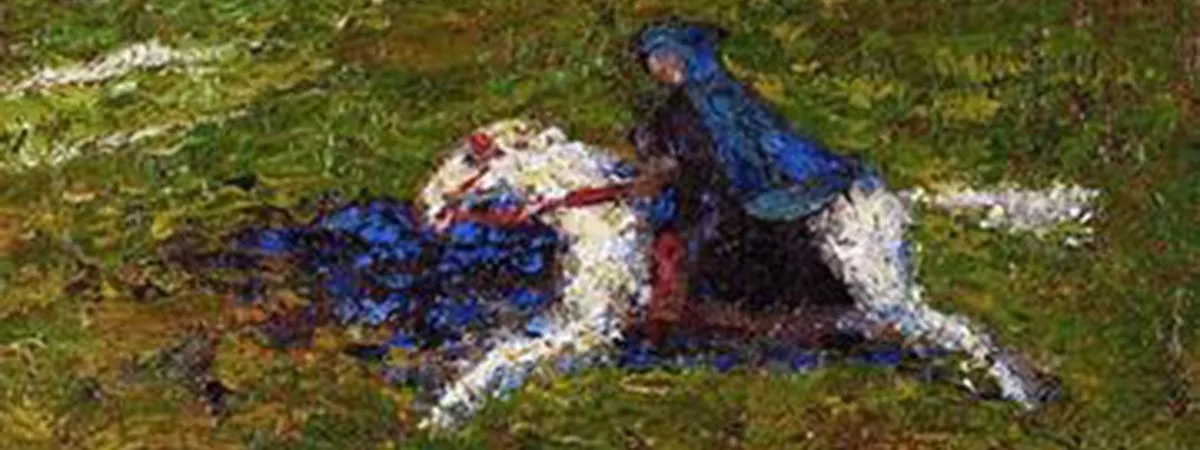Wassily Wassilyevich Kandinsky (December 16, 1866 – December 13, 1944) was a Russian artist who is widely regarded as a pioneer of abstract art and the leading figure in its development. Kandinsky took up art after a life changing experience while listening to a composition of music. Music played a key role in his art and he gave many of his paintings musical titles like Compositions, Improvisations and Impressions. Among these, the most famous are his exemplary 10 compositions, which were created over more than three decades from Composition l in 1907 to Composition X in 1939. Apart from music, the art of Kandinsky was influenced by the Russian Orthodox faith. Another important factor is his lifelong pursuit of the “Great Synthesis of the Arts”, a way to combine different types of art. Understand the art of Russian painter Wassily Kandinsky through an analysis of his art style and career.
Synesthesia
At the age of 30, Wassily Kandinsky was pursuing a law degree in Moscow. He was a lover of music and it was after an extraordinary visual response to a performance of Wagner’s composition Lohengrin at the Bolshoi Theater that he abandoned his law career. He left his native country Russia to study painting at the prestigious Munich Academy of Fine Arts in Germany. He later described the life-changing experience: “I saw all my colors in spirit, before my eyes. Wild, almost crazy lines were sketched in front of me”.

Kandinsky is believed to have had synesthesia, a perceptual phenomenon by which the stimulation of one sense leads to the stimulation of another. Kandinsky described the process of painting similar to that of creating music: “Color is the keyboard, the eyes are the hammer, the soul is the piano with strings. The artist is the hand that plays”. He also thought that colors and marks in a painting triggered particular sounds, just as the musical notes in a symphony triggered particular sights. In the essay “Kandinsky: The Path to Abstraction 1908-1922”, German artist Bruno Haas explained how Kandinsky’s families of colors resonate with one another to produce visual “chords”.
Move To Abstract Art
The early works of Kandinsky, between 1900 and 1910, were mostly impressionistic landscapes and woodblock prints. One of his important paintings in this impressionistic approach is Der Blaue Reiter (The Blue Rider). It is considered a milestone in his transition from impressionism to modern abstract art. Supposedly, the defining moment that moved Kandinsky toward abstract art was when he spotted a picture in his studio during twilight. He recognized just forms and colors that fascinated him. It was then that he decided representationalism only hurt his work.
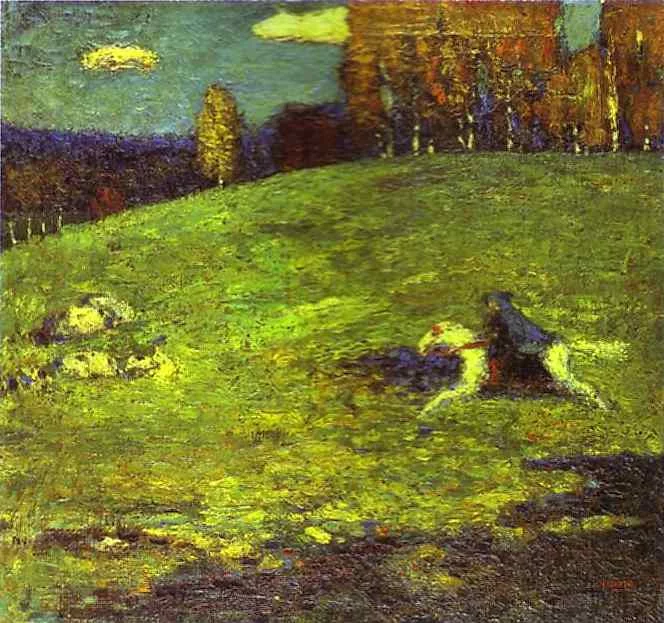
By 1911, Kandinsky had adapted a more gestural, abstract style. The same year, his definitive book, “Concerning the Spiritual in Art” was published. It delves into the purpose of art. Moreover, it examines how colors and forms impact the human soul. According to the book, as abstract art is free from representationalism, colors and forms can display their own spirit.
Composition VII
The idea of music appears everywhere in Kandinsky’s art. For example, he gave many of his paintings musical titles like Compositions, Improvisations and Impressions. Among the musicians who influenced him was the famous Viennese composer Arnold Schonberg. Schönberg abandoned tonal and harmonic conventions in his compositions just like Kandinsky rejected the figure or recognizable object in favor of shapes, lines and discordant colors in his art. Kandinsky aimed to evoke an emotional response in his paintings by creating a rhythmic visual experience through color, line, shape and texture.
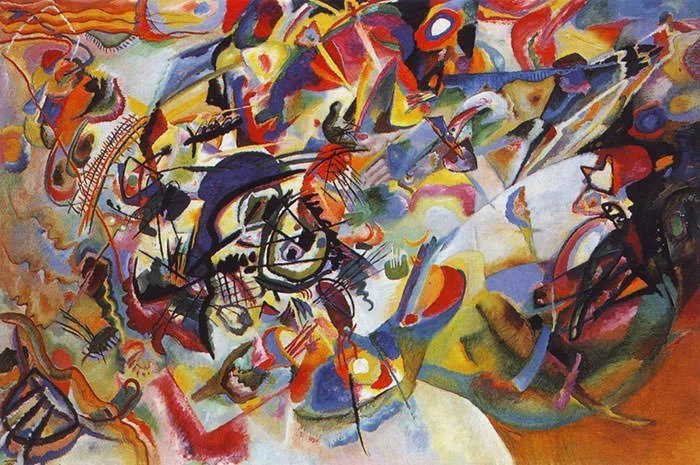
Conservative art experts were critical of Kandinsky and his painting “Composition V” was rejected for an exhibition in 1911. In response, Kandinsky, along with other artists like Franz Marc, founded their own association called Der Blaue Reiter (The Blue Rider), named after a Kandinsky painting. However, the declaration of World War I in 1914 brought an abrupt end to the group and Kandinsky had to return to Moscow. Before that he created Composition VII in 1913. One of his best known works, the painting focuses on the theme of battle and redemption. Kandinsky considered Composition VII to be his most complex masterpiece.
Bauhaus Years
As limits began to be placed on creative freedoms after the Bolshevik Revolution in 1917, Kandinsky returned to Germany. In 1921, at the age of 55, Kandinsky began teaching art at the newly founded Bauhaus school. Calling it “Great Synthesis of the Arts”, Kandinsky wanted to combine different types of art in an effort to simultaneously reveal a universal characteristic in them. He pursued this goal vigorously while teaching at Bauhaus, where artists and craftsmen worked and taught together. Moreover, at Bauhaus, Kandinsky worked with other renowned artists like Paul Klee and Josef Albers.

The art of Kandinsky underwent a stylistic transformation while he was at Bauhaus. This is demonstrated by four particular paintings: Black and Violet (1923), Development (1926), Fragile (1931) and Gloomy Situation (1933). These paintings exhibit a significant evolution in his use of color, form and spatial relations. Moreover, they reveal Kandinsky’s push for the Great Synthesis. Also, he used geometric forms in his art significantly while at the Bauhaus.
In 1926, “Point and Line to Plane”, Kandinsky’s second important book was published. Kandinsky viewed musical scores as a combination of points and lines. He believed that they communicate complex sounds in a simple way. Kandinsky wanted to transfer this simplicity to art: “There is only one way – analytical separation of basic elements to reach one’s own graphic expression.” These basic elements are geometrical circles, squares and triangles, which characterized Kandinsky’s work during his Bauhaus phase.
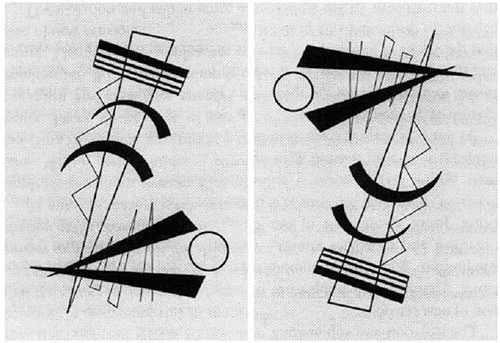
In 1933, not long after assuming power, the Nazi party closed the Bauhaus. This led to Kandinsky moving to Paris at the age of 67. He spent the last 11 years of his life there. His style of painting underwent another change in France. He used diagrams of amoebas, embryos, and other primitive cellular and plant forms for bio-morphic imagery that would be predominant in his art from this period. Moreover, instead of his characteristic primary colors he started favoring softer, pastel hues like pink, violet, turquoise and gold.
Analysis
The art of Kandinsky may be studied by reading his own writing. In his book “On the Spiritual in Art”, Kandinsky puts forward four points to argue the meaningfulness of forms. He first observes that color can be warm and cold; and light and dark. Moreover, there is a lightness and darkness in both warm and cold colors. Secondly, there is a horizontal movement between yellow and blue; and between black and white. However, the black-white spectrum remains inactive because of its lack of warmth and coolness. Thirdly, a color’s movement toward white represents eternal resistance and the birth of ideas; whereas color’s movement toward black eliminates resistance and represents the death of possibilities. Lastly, black and white imply other metaphysical realms.
The paintings of Kandinsky were created according to these theories. For example, he found that the color blue implies depth and its movement away from the viewer allows it to be confined to a geometric form without putting the viewer ill-at-ease. Similarly, white is full of possibilities and symbolic of “the nothingness that exists before birth”; while black is its opposite and represents “an eternal silence without future”. Moreover, he believed that yellow could disturb while blue awakened the highest spiritual aspirations.
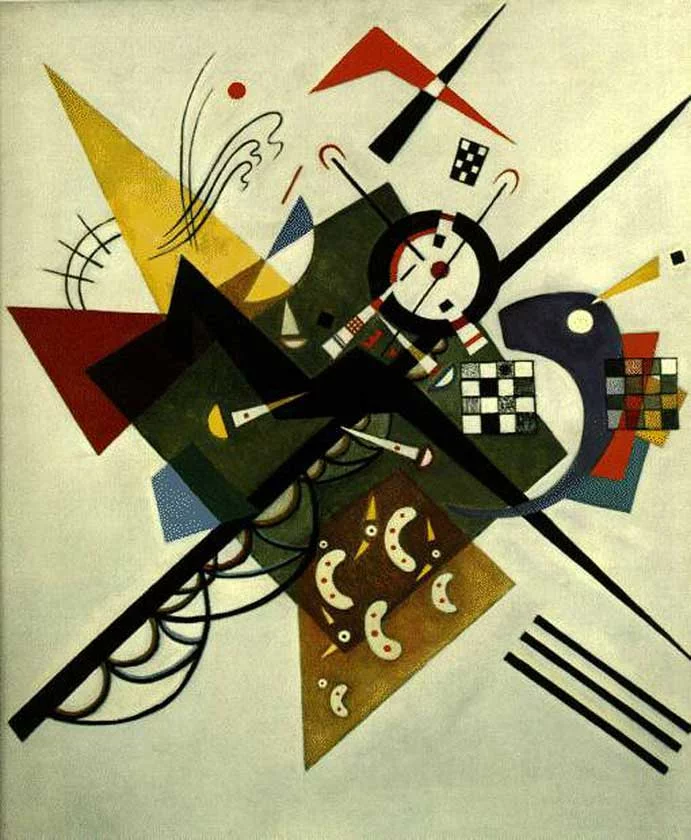
Kandinsky believed that color induces a physical and an emotional response. This response depends on how color is used in relationship to form in a painting. Moreover, Kandinsky believed that an artist could create a unified composition in which actions, secret thoughts and feelings could be visualized in a spiritual atmosphere of color.
British art historian Paul Overy states that Kandinsky exhibited a certain sensitivity to external events and demonstrated an almost uncanny ability to read the mood of the time, which he then imbued into his paintings. There was no shortage of dramatic events in his life like World War I, the Bolshevik Revolution in 1917 and the pressure the Nazi government put on him once they assumed power. For example, Kandinsky painted Gloomy Situation the year the Bauhaus was forced to shut down by the Nazis.

Among the most important influences on the art of Kandinsky was the Russian Orthodox faith, in which he was raised. Kandinsky has used a number of symbols from this faith in his paintings. For example, in his painting the Blue Rider, he used the image of Saint George the Dragon Slayer along with the color blue, which had spiritual significance for him. The combination may be considered as a triumphant symbol for the modernist movement, in which he operated.
Main Sources:-
Brooks, Deanna. (2016). “It Could Have Been Great: An Examination of Kandinsky’s Bauhaus Paintings and the Great Synthesis of the Arts”.
“Why Kandinsky chose to make abstract art”. Deutsche Welle.
B. Miller, Renee. (2014). “Wassily Kandinsky’s Symphony of Colors”. Denver Art Museum.
Taggart, Emma. (2020). “Discover the Famous Works of Wassily Kandinsky, the Artist Who Painted Music”. My Modern MET.
McBurney Gerard. (2006). “Wassily Kandinsky: the painter of sound and vision”. The Guardian.
“Wassily Kandinsky: The road to abstraction”. Christie’s.
(2014). “Kandinsky in Paris, 1934–1944”. The Solomon R. Guggenheim Foundation.

